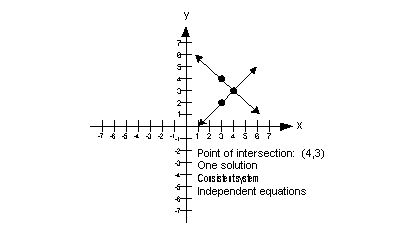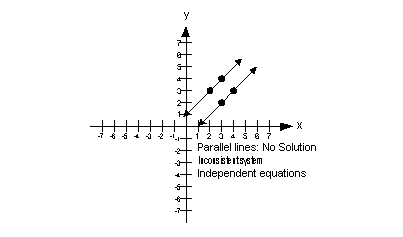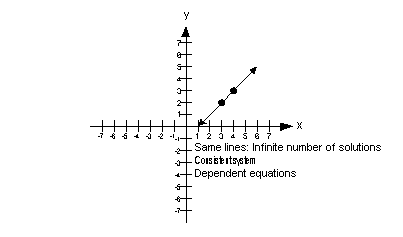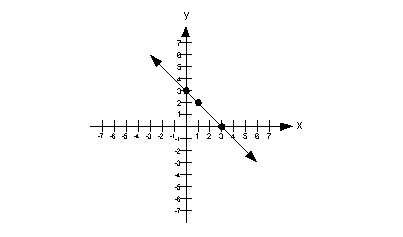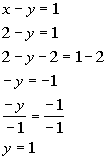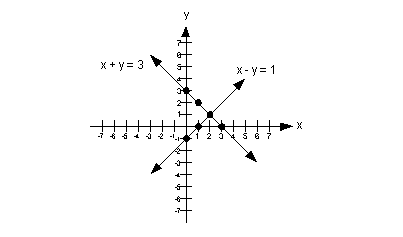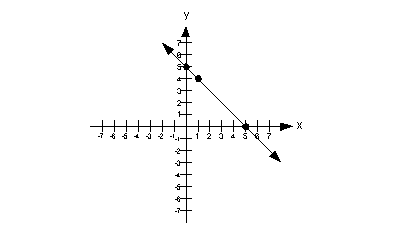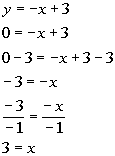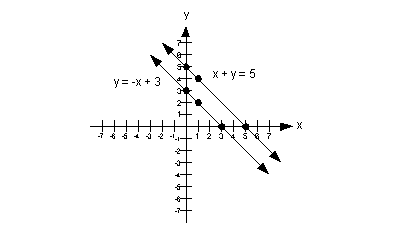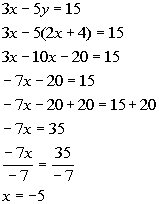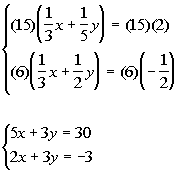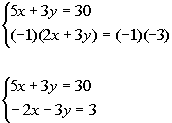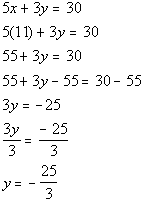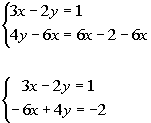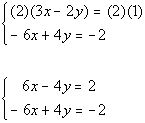Determine the Number of Solutions in a System of Equations
| WTAMU > Virtual Math Lab > Intermediate Algebra After completing this tutorial, you should be able to:
In this tutorial we will be specifically looking at systems that have two equations and two unknowns. Tutorial 20: Solving Systems of Linear Equations in Three Variables will cover systems that have three equations and three unknowns. We will look at solving them three different ways: graphing, substitution method and elimination method. This will lead us into solving word problems with systems, which will be shown in Tutorial 21: Systems of Linear Equations and Problem Solving. That is where we get to answer the infamous question, when will we use this? But first, we have to learn how to work with systems in general. That is why we use generic variables like x and y at this point. If you know how to work it out in general, then when you have a specific problem that you are solving where the variables take on meaning like time or money (two things we don't ever seem to have enough of) you will be ready to go. So, let's go ahead and look at systems in general to get us ready for the word problems that are ahead of us. A system of linear equations is two or more linear equations that are being solved simultaneously. In this tutorial, we will be looking at systems that have only two linear equations and two unknowns. In general, a solution of a system in two variables is an ordered pair that makes BOTH equations true. In other words, it is where the two graphs intersect, what they have in common. So if an ordered pair is a solution to one equation, but not the other, then it is NOT a solution to the system. A consistent system is a system that has at least one solution. An inconsistent system is a system that has no solution. The equations of a system are dependent if ALL the solutions of one equation are also solutions of the other equation. In other words, they end up being the same line. The equations of a system are independent if they do not share ALL solutions. They can have one point in common, just not all of them. There are three possible outcomes that you may encounter when working with these systems:
One Solution If you do get one solution for your final answer, is this system consistent or inconsistent? If you do get one solution for your final answer, would the equations be dependent or independent? The graph below illustrates a system of two equations and two unknowns that has one solution: No Solution If you get no solution for your final answer, is this system consistent or inconsistent? If you get no solution for your final answer, would the equations be dependent or independent? The graph below illustrates a system of two equations and two unknowns that has no solution: Infinite Solutions If you get an infinite number of solutions for your final answer, is this system consistent or inconsistent? If you get an infinite number of solutions for your final answer, would the equations be dependent or independent? The graph below illustrates a system of two equations and two unknowns that has an infinite number of solutions: Let's check the ordered pair (3, -1) in the first equation:
So far so good, (3, -1) is a solution to the first equation x + y = 2. Now, let's check (3, -1) in the second equation:
Hey, we ended up with another true statement, which means (3, -1) is also a solution to the second equation x - y = 4. Here is the big question, is (3, -1) a solution to the given system????? Now let's put (0, 2) into the first equation:
This is a true statement, so (0, 2) is a solution to the first equation x + y = 2. Finally, let's put (0,2) into the second equation:
This time we got a false statement, you know what that means. (0, 2) is NOT a solution to the second equation x - y = 4. Here is the big question, is (0, 2) a solution to the given system????? Equations in Two Variables There are three ways to solve systems of linear equations in two variables:
Step 1: Graph the first equation. Step 2: Graph the second equation on the same coordinate system as the first. You graph the second equation the same as any other equation. Refer to the first step if you need to review the different ways to graph a line. The difference here is you will put it on the same coordinate system as the first. It is like having two graphing problems in one. Step 3: Find the solution. If the two lines intersect at one place, then the point of intersection is the solution to the system. If the two lines are parallel, then they never intersect, so there is no solution. If the two lines lie on top of each other, then they are the same line and you have an infinite number of solutions.. In this case you can write down either equation as the solution to indicate they are the same line. Step 4: Check the proposed ordered pair solution in BOTH equations. You can plug in the proposed solution into BOTH equations. If it makes BOTH equations true then you have your solution to the system. If it makes at least one of them false, you need to go back and redo the problem.
The x-intercept is (3, 0). y-intercept
The y-intercept is (0, 3). Find another solution by letting x = 1.
Another solution is (1, 2).
Plotting the ordered pair solutions and drawing the line:
The x-intercept is (1, 0). y-intercept
The y-intercept is (0, -1). Find another solution by letting x = 2.
Another solution is (2, 1). Solutions:
Plotting the ordered pair solutions and drawing the line: We need to ask ourselves, is there any place that the two lines intersect, and if so, where? The answer is yes, they intersect at (2, 1). You will find that if you plug the ordered pair (2, 1) into BOTH equations of the original system, that this is a solution to BOTH of them. The solution to this system is (2, 1).
The x-intercept is (5, 0). y-intercept
The y-intercept is (0, 5). Find another solution by letting x = 1.
Another solution is (1, 4). Solutions:
Plotting the ordered pair solutions and drawing the line:
The x-intercept is (3, 0). y-intercept
The y-intercept is (0, 3). Find another solution by letting x = 1.
Another solution is (1, 2). Solutions:
Plotting the ordered pair solutions and drawing the line: We need to ask ourselves, is there any place that the two lines intersect, and if so, where? The answer is no, they do not intersect. We have two parallel lines. There are no ordered pairs to check. The answer is no solution. Step 1: Simplify if needed. This would involve things like removing ( ) and removing fractions. To remove ( ): just use the distributive property. To remove fractions: since fractions are another way to write division, and the inverse of divide is to multiply, you remove fractions by multiplying both sides by the LCD of all of your fractions. Step 2: Solve one equation for either variable. It doesn't matter which equation you use or which variable you choose to solve for. You want to make it as simple as possible. If one of the equations is already solved for one of the variables, that is a quick and easy way to go. If you need to solve for a variable, then try to pick one that has a 1 as a coefficient. That way when you go to solve for it, you won't have to divide by a number and run the risk of having to work with a fraction (yuck!!). Step 3: Substitute what you get for step 2 into the other equation . This is why it is called the substitution method. Make sure that you substitute the expression into the OTHER equation, the one you didn't use in step 2. This will give you one equation with one unknown. Step 4: Solve for the remaining variable . Step 5: Solve for second variable. If you come up with a value for the variable in step 4, that means the two equations have one solution. Plug the value found in step 4 into any of the equations in the problem and solve for the other variable. If your variable drops out and you have a FALSE statement, that means your answer is no solution. If your variable drops out and you have a TRUE statement, that means your answer is infinite solutions, which would be the equation of the line. Step 6: Check the proposed ordered pair solution in BOTH original equations. You can plug in the proposed solution into BOTH equations. If it makes BOTH equations true, then you have your solution to the system. If it makes at least one of them false, you need to go back and redo the problem. Both of these equations are already simplified. No work needs to be done here. Note how the second equation is already solved for y . We can use that one for this step. It does not matter which equation or which variable you choose to solve for. But it is to your advantage to keep it as simple as possible. Second equation solved for y :
Substitute the expression 2 x + 4 for y into the first equation and solve for x :
Plug in -5 for x into the equation in step 2 to find y 's value.
You will find that if you plug the ordered pair (-5, -6) into BOTH equations of the original system, that this is a solution to BOTH of them. (-5, -6) is a solution to our system. Both of these equations are already simplified. No work needs to be done here. This time, the problem was not so nice to us, we will have to do a little work to get one equation solved for one of our variables. It does not matter which equation or which variable you choose to solve for. Just keep it simple. Since the x in the first equation has a coefficient of 1, that would mean we would not have to divide by a number to solve for it and run the risk of having to work with fractions (YUCK!!) The easiest route here is to solve the first equation for x , and we definitely want to take the easy route. You would not be wrong to either choose the other equation and/or solve for y, again you want to keep it as simple as possible. Solving the first equation for x we get:
Substitute the expression 5 + 2 y for x into the second equation and solve for y :
Wait a minute, where did our variable go???? As mentioned above if your variable drops out and you have a FALSE statement, then there is no solution. If we were to graph these two, they would be parallel to each other. Since we did not get a value for y , there is nothing to plug in here. There are no ordered pairs to check. The answer is no solution. This methods is also known as the addition or the elimination by addition method. Step 1: Simplify and put both equations in the form Ax + By = C if needed. This would involve things like removing ( ) and removing fractions. To remove ( ): just use the distributive property. To remove fractions: since fractions are another way to write division, and the inverse of divide is to multiply, you remove fractions by multiplying both sides by the LCD of all of your fractions. Step 2: Multiply one or both equations by a number that will create opposite coefficients for either x or y if needed. Looking ahead, we will be adding these two equations together. In that process, we need to make sure that one of the variables drops out, leaving us with one equation and one unknown. The only way we can guarantee that is if we are adding opposites. The sum of opposites is 0. If neither variable drops out, then we are stuck with an equation with two unknowns which is unsolvable. It doesn't matter which variable you choose to drop out. You want to keep it as simple as possible. If a variable already has opposite coefficients than go right to adding the two equations together. If they don't, you need to multiply one or both equations by a number that will create opposite coefficients in one of your variables. You can think of it like a LCD. Think about what number the original coefficients both go into and multiply each separate equation accordingly. Make sure that one variable is positive and the other is negative before you add. For example, if you had a 2 x in one equation and a 3 x in another equation, we could multiply the first equation by 3 and get 6 x and the second equation by -2 to get a -6 x . So when you go to add these two together they will drop out. Add the two equations together. The variable that has the opposite coefficients will drop out in this step and you will be left with one equation with one unknown. Step 4: Solve for remaining variable. Solve the equation found in step 3 for the variable that is left. If you need a review on this, go to Tutorial 7: Linear Equations in One Variable. If both variables drop out and you have a FALSE statement, that means your answer is no solution. If both variables drop out and you have a TRUE statement, that means your answer is infinite solutions, which would be the equation of the line. Step 5: Solve for second variable. If you come up with a value for the variable in step 4, that means the two equations have one solution. Plug the value found in step 4 into any of the equations in the problem and solve for the other variable. Step 6: Check the proposed ordered pair solution in BOTH original equations. You can plug the proposed solution into BOTH equations. If it makes BOTH equations true, then you have your solution to the system. If it makes at least one of them false, you need to go back and redo the problem. This equation is full of those nasty fractions. We can simplify both equations by multiplying each separate one by it's LCD, just like you can do when you are working with one equation. As long as you do the same thing to both sides of an equation, you keep the two sides equal to each other. Multiplying each equation by it's respective LCD we get:
Again, you want to make this as simple as possible. Note how the coefficients on both y 's are 3. We need to have opposites, so if one of them is 3 and the other is -3, they would cancel each other out when we go to add them. If we added them together the way they are now, we would end up with one equation and two variables, nothing would drop out. And we would not be able to solve it. I propose that we multiply the second equation by -1, this would create a -3 in front of x and we will have our opposites. Note that we could just as easily multiply the first equation by -1 and not the second one. Either way will get the job done. Multiplying the second equation by -1 we get:
You can choose any equation used in this problem to plug in the found x value. I choose to plug in 11 for x into the first simplified equation (found in step 1) to find y 's value.
You will find that if you plug the ordered pair (11, -25/3) into BOTH equations of the original system, that this is a solution to BOTH of them. (11, -25/3) is a solution to our system. This problem is already simplified. However, the second equation is not written in the form Ax + By = C. In other words, we need to write it in this form so everything is lined up ready to go when we add the two equations together. Rewriting the second equation we get:
Note that if we multiply the first equation by 2, then we will have a -6 x which is the opposite of the 6 x found in the second equation. Multiplying the first equation by 2 we get:
Hey where did our variables go?? As mentioned above, if the variable drops out AND we have a TRUE statement, then when have an infinite number of solutions. They end up being the same line. There is no value to plug in here. There is no value to plug in here. When they end up being the same equation, you have an infinite number of solutions. You can write up your answer by writing out either equation to indicate that they are the same equation. Two ways to write the answer are {( x , y )| 3 x - 2 y = 1} OR {( x , y ) | 4 y = 6 x - 2}. These are practice problems to help bring you to the next level. It will allow you to check and see if you have an understanding of these types of problems. Math works just like anything else, if you want to get good at it, then you need to practice it. Even the best athletes and musicians had help along the way and lots of practice, practice, practice, to get good at their sport or instrument. In fact there is no such thing as too much practice. To get the most out of these, you should work the problem out on your own and then check your answer by clicking on the link for the answer/discussion for that problem. At the link you will find the answer as well as any steps that went into finding that answer.
| ||||||||||||||||||||||||||||||||||||||||||||||||||||||||||||||||||||||||||||||||||||||||||||||||||||||||||
Determine the Number of Solutions in a System of Equations
Source: https://www.wtamu.edu/academic/anns/mps/math/mathlab/int_algebra/int_alg_tut19_systwo.htm
